The ups and downs of high rise in Alice Springs
12 August 2019
In the Northern Territory major news topics are cyclic in nature, invariably extensively covered several times yet – like the proverbial goldfish swimming endlessly around in its fishbowl – quickly fading from public memory on every occasion.
At a predicted cost of $100m and eight storeys tall the Melanka project would have been the mother of all Alice Springs high rises. But alas, it never happened.
The public is generally oblivious to this pattern and so is taken along for the ride on the media merry-go-round; which, incidentally, is very useful for government, bureaucracy and big business in creating illusions of progress.
However, such behaviour creates its own distinctive patterns of which those in control are clearly unaware.
One issue that often arises in Alice Springs is the debate over high rise developments exceeding the long mandated three-storey height limit.
This began as a recommendation of the 1969 HKF Report, the Tourism Plan for Central Australia instigated by the (then) Australian Tourist Commission.
In April 1970 the Town Management Board supported in principle the height restrictions of the HKF Report, not least by District Officer Dan Conway who “thoroughly agreed with the recommendation for a three-storey height limit for motels around the town-suburban area”.
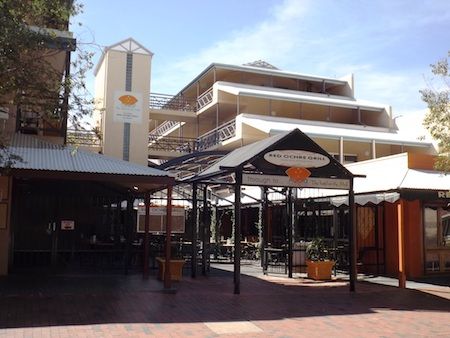 Regional Engineer Kevin Sweet declared: “If we do not support this we should be hemmed in by skyscrapers which would destroy the attraction of the town.” (Centralian Advocate, 16/4/70).
Regional Engineer Kevin Sweet declared: “If we do not support this we should be hemmed in by skyscrapers which would destroy the attraction of the town.” (Centralian Advocate, 16/4/70).
Attempts to override that recommendation were not long in coming.
AT LEFT: Territory Motor Inn.
In late 1973 three major hotel developments were proposed for the Alice Springs CBD, including a “high-rise private hotel” up to 11 storeys high in Hartley Street near the Old Courthouse.
These major projects were exquisitely mistimed.
Since the mid 1960s Alice Springs had undergone a major expansion, at times posting the highest percentage population growth rate in Australia; but this came to a shuddering halt as the first major recession since the 1930s bit hard into the Territory’s economy.
Business confidence did not return until the NT attained self-government in 1978.
The Memorandum Of Understanding (MOU) between the Federal and NT governments provided for extraordinarily generous Commonwealth largesse for several years.
Flush with funds, the Territory embarked on a major new economic growth phase.
In 1979 the NT Government commenced its first review of town planning regulations for Alice Springs, inclu ding building height limits.
ding building height limits.
This triggered an occasionally acrimonious public debate that was destined to flare several times during the ensuing decade.
With population growth and tourism surging, once again there were three major hotel developments proposed for Alice Springs.
AT RIGHT: 11 storeys that never happened.
In late 1980 an unnamed Asian consortium sought approval for a large five-storey hotel complex on the town’s western fringe, located in the vicinity of the old Carmichael Caravan Park.
In June 1981 a Hilton Hotel was announced as part of the planned new Golf Course subdivision along Barrett Drive.
However, it was in July 1982 that plans for a massive 10-storey hotel were submitted to replace the Stuart Arms Hotel on the corner of Todd and Parsons Streets (now the Alice Plaza).
As happened almost a decade earlier, these major hotel projects coincided with a severe national economic recession.
None proceeded although the site for the proposed Hilton Hotel was later developed as the Sheraton Hotel (now Doubletree-on-Hilton).
Unlike the 1970s, the Territory escaped the ravages of the early 1980s downturn, insulated by the Commonwealth’s continued largesse of the MOU.
Debate over height limits persisted during 1983-4 due to Charles Perkins who, as head of the Aboriginal Development Commission, doggedly pursued the development of a six-storey office block on land in Hartley Street that was gifted to the ADC by the Uniting Church.
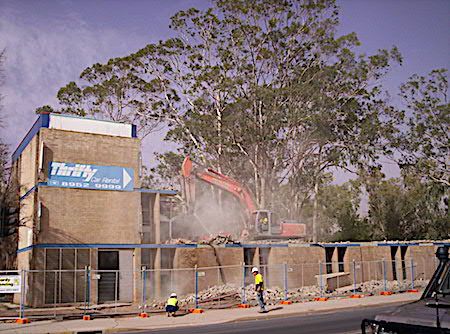 The controversy ended when Perkins was appointed as deputy secretary for the Department of Aboriginal Affairs in early 1985, whereupon plans for the multi-storey office project were shelved and ultimately replaced with the Yeperenye Shopping Centre.
The controversy ended when Perkins was appointed as deputy secretary for the Department of Aboriginal Affairs in early 1985, whereupon plans for the multi-storey office project were shelved and ultimately replaced with the Yeperenye Shopping Centre.
AT LEFT: Melanka demolition.
There was a major difference with Perkins’s high-rise proposal and of the earlier hotel projects, with the former to be financed by public funding while the hotels were backed by private wealth.
This distinction appears to be significant.
A twist to this theme arose in 1986.
The mid 1980s was a boom time nationally and worldwide during the “greed is good” era – except for the NT, when a hostile Federal Labor Government tightened the financial screws as the MOU for self-government drew to a close.
In late 1986 the renamed Lasseters Casino (a more recent photo at left) under new ownership, commenced major renovations which intended new buildings at the front up to five storeys high.
This fanned the flames of controversy yet again and the plans were dropped.
Building height limits remained quiescent until late 1989 when the Alice Springs Town Council voted to conditionally support lifting the restrictions (stoutly opposed by Mayor Leslie Oldfield who was supported only by Alderman Loraine Braham).
At this time the NT was on the ropes and the national economy was clearly declining.
The NT Government, highly sensitive to planning controversies in Alice Springs, kyboshed the town council’s initiative.
However, there was one significant exception.
The redevelopment of the Territory Motor Inn was underway – the property in Todd Mall opposite the John Flynn Memorial Church which stretched over to Leichhardt Terrace.
This was the project that caused the infamous overnight destruction of Marron’s Newsagency (below right) on July 31, 1988.
The project had approval for construction of the town’s first four-storey complex.
As it neared completion, the town council lauded “the new four-storey Territory Motor Inn as an example of the type of development council would like to see” (Advocate, 2/2/90).
The grand re-opening was celebrated on the weekend of March 31 and April 1 with proceedings compered by TV celebrity garden guru, Don Burke.
By the end of August 1990 – a scant four months later – the Territory Motor Inn was placed into receivership.
It’s likely that in the Territory there has never been another fall from grace as swift as that of the first four-storey building in Alice Springs.
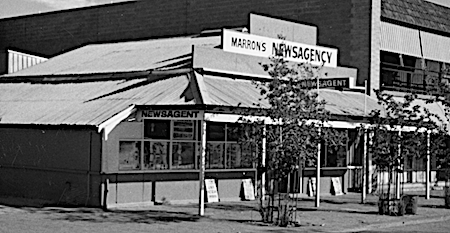
The collapse of the Territory Motor Inn was concurrent with the onset of “the recession we had to have” of the early 1990s.
This economic downturn is officially the last recession Australia endured; unlike a decade earlier, the Territory was not spared its impact.
As the NT and Australia recovered and then prospered into the 1990s and early in the new century, the Alice’s building height limits vanished as a topic of public discourse.
In August 2006 the venerable three-storey Melanka Lodge complex was sold to Cairns-based Gilligan’s Group which announced it would be replaced by a four-storey luxury hotel and backpackers resort, with provision also for rented accommodation for staff of the nearby Alice Springs Hospital, too.
Work was anticipated to start in 2007 but the project was put on hold as uncertainty began to afflict the national and world economies.
In October 2008 Melanka was demolished to create a cleared site as the owners put the property up for sale – which coincided precisely with the world’s economy entering into freefall as the Global Financial Crisis took hold.
The site was acquired by CJHA Constructions, a subsidiary of east coast developers the Ainsworth family, and in October 2009 new plans were put on display for the construction of several five-storey blocks for residential apartments, tourist accommodation and retail shops – potentially “one of the town’s largest single development projects” (Advocate, 6/10/09).
Meanwhile the worst economic crisis since the Great Depression deepened as the GFC gripped the world.
Although the national economy plunged, Australia avoided recession through a combination of massive expenditure by the Federal Government and a surge of mineral exports to China which also embarked on a colossal capital works program.
Australia’s escape echoed that of the Northern Territory’s experience during the recession of the early 1980s, protected by capital works expenditure funded by the MOU for self-government.
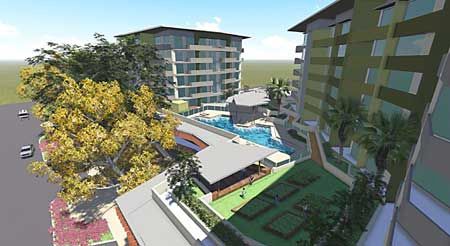 The mother of all high rise projects was proposed in 2014 when Eden Developments (NT) Pty Ltd, understood to be linked to the Ainsworths, proposed for the Melanka block “The Big One that could end the gloom” (Alice Springs News, 25/11/2014): “A $100m project, eight storeys high, 170 dwellings, an 85 room hotel, professional office space, restaurants, cafes – even a 110 place child care centre – all that adjacent to the CBD, on the empty Melanka site, now a painful symbol of the town’s economic malaise.”
The mother of all high rise projects was proposed in 2014 when Eden Developments (NT) Pty Ltd, understood to be linked to the Ainsworths, proposed for the Melanka block “The Big One that could end the gloom” (Alice Springs News, 25/11/2014): “A $100m project, eight storeys high, 170 dwellings, an 85 room hotel, professional office space, restaurants, cafes – even a 110 place child care centre – all that adjacent to the CBD, on the empty Melanka site, now a painful symbol of the town’s economic malaise.”
This ignited a massive public controversy, reported extensively in these pages and drawing many comments from readers (the writer contributed).
The Melanka site project did not proceed and the Ainsworth family put the property up for sale with the eight story approval still in place.
Needless to say, the site remains vacant and desolate.
By this time the town’s biggest multi-storey construction project which became reality had commenced – the NT Supreme Court building in Parsons Street.
Its origin can be traced back to Justice Dean Mildren complaining about the inadequacy of the existing local courthouse: “I’m afraid this court is out of date, we need a new courthouse here – not that we should get rid of this one”.
Prosecutor Nanette Rogers, perhaps inadvertently, threw down the gauntlet: “It may be after your time and my time, Your Honour” (Advocate, 4/12/09).
The now vacant Commonwealth Bank building in Parsons Street was acquired for a new multi-storey office block that would be partially leased to the NT Government to provide accommodation for the Supreme Court.
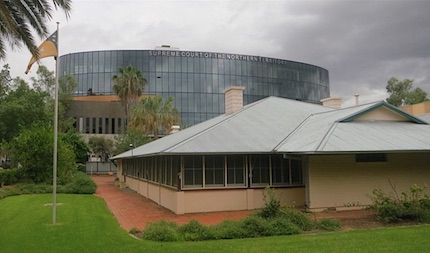 As construction proceeded it was the building’s design rather than its height that prompted most consternation, with the sheer oval-shaped upper levels of the five-storey edifice clad entirely in tinted glass panels.
As construction proceeded it was the building’s design rather than its height that prompted most consternation, with the sheer oval-shaped upper levels of the five-storey edifice clad entirely in tinted glass panels.
Dubbed unkindly by some as the “fishbowl”, the Supreme Court building (at left, overshadowing the historic Residency) is spectacularly apt for the goldfish-in-a-bowl analogy for the history of high rise projects in Alice Springs.
The new Supreme Court building was officially opened in 2017.
What does the extraordinary correlation of Alice Springs high rise projects and major economic downturns mean?
It seems to be much more than simple coincidence.
The pattern shows that the taller the project proposals, or the bigger the actual construction above three storeys (1990), the more severe are the recessions or downturns occurring at these times.
Equally significant is that all of these projects are privately backed, not supported by public expenditure.
Why is this pattern so strong in Alice Springs, probably unique in the world?
The answer is unknown but is likely to be a combination of factors including geography, population dynamics, and group psychology and behaviour.
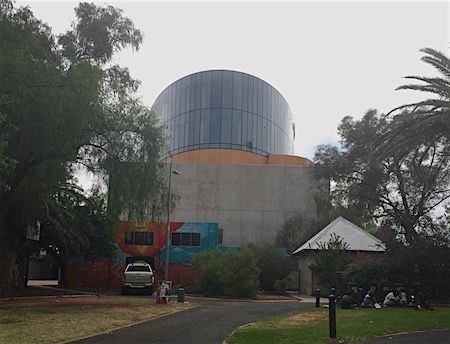 The “dismal science” of economics is notorious for the inaccuracy of its predictions, as wryly noted in the quip that God invented economists in order to make weather forecasters feel good about themselves.
The “dismal science” of economics is notorious for the inaccuracy of its predictions, as wryly noted in the quip that God invented economists in order to make weather forecasters feel good about themselves.
Despite this, recent history indicates that Alice Springs appears to be an accurate barometer of major national and international economic tempests.
Does the new Supreme Court building (at right) fit this mould?
It represents a departure from the model in that it’s a privately financed and owned property built to service the requirements of government.
This is nothing new in itself but the distinction here is the new building’s height and whether this factor bears any relationship to general economic conditions.
The indications are ominous, as there is any number of alarms signalling that the Northern Territory, Australia and, indeed, the world is perilously close to weathering the next major economic storm.



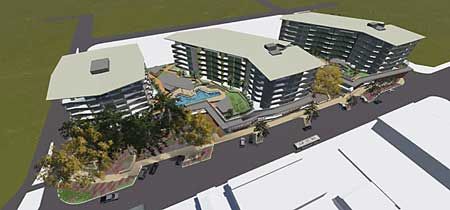
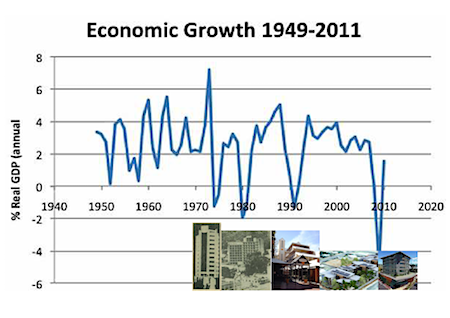
This phenomenon would appear to be associated with some towns or cities who playing second or third fiddle economically to the state capital.
An example would be Launceston, which has a rich commercial history, problematic recent commercial development and ongoing ups and downs in regards to high rise.
Tasmania also has a north south divide similar to the NT, with Launceston mostly playing second fiddle to Hobart.
Yet again a welcome historic overview from Alex.